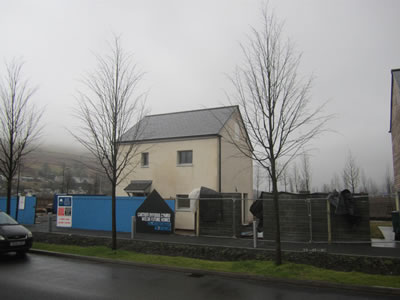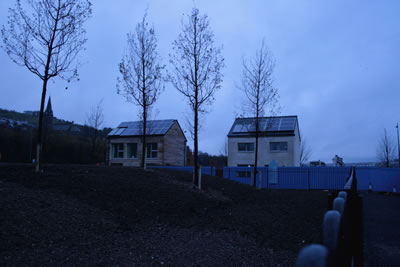The two-bedroom, ultra low-cost Lime House in Ebbw Vale has just been awarded full Passivhaus certification. It also achieves code 5 of the Code for Sustainable Homes.
Neighbour to the already certified, zero carbon (code 6) Larch House, both houses were designed to meet the demanding performance criteria of the passivhaus standard in this exposed and misty, hilltop location in south Wales. The Lime House is cheaper to build than the Larch House because it has smaller windows which do not need blinds for summer shading, reducing the cost of the windows and eliminating the cost of the blinds. It is named after its lime rendered walls, and follows the unfussy form of a traditional Welsh cottage. Its simple, compact shape minimises the surface area from which it can lose heat, as well as the amount of insulation it needs.
The Lime House uses locally sourced and manufactured goods and materials wherever possible. Welsh skills, suppliers and products have contributed to one of the most energy efficient houses ever built in the UK.
In the Lime House, we were able to install the first UK-produced, triple-glazed, certified Passivhaus windows, which we developed with Wood Knowledge Wales and Bill Robertson, using Welsh wood for the insulated window frames. All of the windows and the front door use Welsh larch timber, thermally modified in Anglesey; most of the timber for the doors, wall panels, floor slabs and roof elements is from Welsh forests; most of the insulation is made in Wales, and the roof tiles come from a factory only two miles away. The staircase, the stonework and even the solar panels have all been made in Wales.
The closed-panel timber frame system was developed in close collaboration with Holbrook Timber Frame using Welsh timber, adapting framing techniques from German Passivhaus dwellings for use with faster-growing, softer Welsh timber. The panels are filled with Welsh-produced insulation in the factory, then clad on site with two further coats of insulation: a thick layer of natural loose-fill wood fibre on the inside, and the same depth of rigid wood fibre board on the outside, rendered with a thin coat lime render.
Both houses are currently being carefully monitored with funding from the Technology Strategy Board (TSB) with tenants moving in after the initial research phase. The monitoring will provide independent analysis of both the technical performance of the building and the level of satisfaction of the occupants and will provide an independent assessment of how closely performance matches our design intent.
The United Welsh Housing Association, partners in the project, would like to replicate the innovative features of these houses in future affordable housing schemes, reducing their tenants’ household energy bills and protecting them from fuel poverty. Energy preservation is a key element of sustainable living and it is important that we continue to build houses like these that incorporate low building costs and low running costs.

